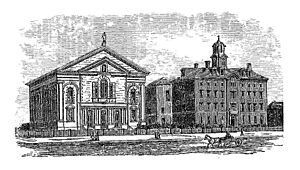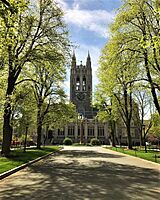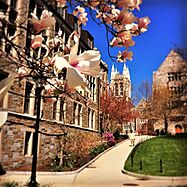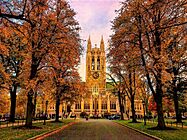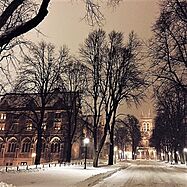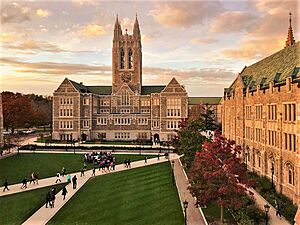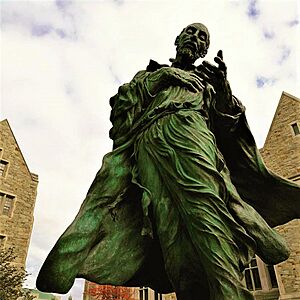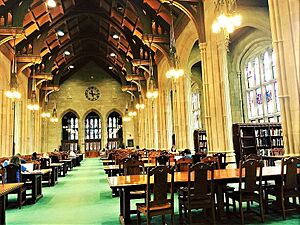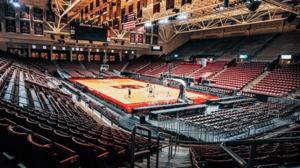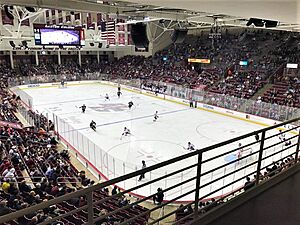Boston College facts for kids
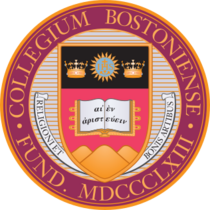 |
|
| Latin: Collegium Bostoniense | |
| Motto | Αἰὲν ἀριστεύειν (Greek) |
|---|---|
|
Motto in English
|
"Ever to Excel" |
| Type | Private research university |
| Established | March 31, 1863 |
| Founder | John McElroy |
| Accreditation | NECHE |
|
Religious affiliation
|
Roman Catholic (Jesuit) |
|
Academic affiliations
|
|
| Endowment | $3.777 billion (2024) |
| President | William P. Leahy |
| Provost | David Quigley |
|
Academic staff
|
1,848 |
|
Administrative staff
|
2,690 |
| Students | 15,106 (2022) |
| Undergraduates | 9,532 (2022) |
| Postgraduates | 5,574 (2022) |
| Location |
,
,
United States
42°20′06″N 71°10′13″W / 42.33500°N 71.17028°W |
| Campus |
|
| Newspaper | The Heights |
| Colors | Maroon and gold |
| Nickname | Eagles |
|
Sporting affiliations
|
|
| Mascot | Baldwin the Eagle |
 |
|
Boston College (BC) is a private university in Chestnut Hill, Massachusetts, USA. It is a Catholic university founded by the Jesuits, a religious order, in 1863. Today, Boston College has more than 15,000 students.
Boston College was first located in Boston before moving most of its campus to Chestnut Hill in 1907. Its main campus is a historic area known for its beautiful "collegiate gothic" buildings. The campus is about 6 miles west of downtown Boston.
BC offers different types of degrees, including bachelor's, master's, and doctoral degrees. It has nine colleges and schools. Boston College is known as a "Research 1" university, meaning it does a lot of research and awards many doctoral degrees.
The sports teams at Boston College are called the Eagles. Their colors are maroon and gold, and their mascot is Baldwin the Eagle. The Eagles compete in NCAA Division I sports, mostly as part of the Atlantic Coast Conference. Their men's ice hockey team has won five national championships!
Many famous people have attended Boston College, including governors, ambassadors, members of Congress, writers, actors, and professional athletes.
Contents
History of Boston College
Boston College was started by the first Jesuit community in New England in 1849. A Jesuit priest named John McElroy saw the need for a school for the many Irish Catholic immigrants. He raised money and bought land for "The Boston College" in 1857.
On April 1, 1863, the state of Massachusetts officially allowed the college to grant degrees. John Bapst became the first President, and classes began on September 5, 1864.
Early Years and Learning
In its early years, many students were around fourteen years old. This was common for Jesuit schools, which often included high school-level studies. Most students were local boys from Boston. Campus life focused on religious activities, with Catholic students attending Mass and joining religious groups. The school's learning plan, called the Ratio Studiorum, focused on subjects like Latin, Greek, philosophy, and theology.
Over time, the high school part of Boston College grew. In 1927, Boston College High School became a separate school.
Moving to Chestnut Hill
In 1907, the new president, Thomas I. Gasson, decided that the old campus in Boston was too small. He imagined Boston College as a leading Jesuit school on a hill, like a "city upon a hill". He bought a farm in Chestnut Hill, about six miles west of downtown Boston.
Construction on the new campus began in 1909. By 1913, they ran out of money, so Gasson Hall, the main building, stood alone for three years. Even though all the original plans weren't finished, President Gasson's dream for the new campus came true.
Growing Academics and Women Students
In the 1920s, Boston College started adding more schools. These included the Graduate School of Arts & Sciences, the Boston College Law School, and the Woods College of Advancing Studies. Later, they added schools for social work, business, nursing, and education.
In 1926, Boston College gave degrees to women for the first time. However, it didn't become fully coeducational (meaning both men and women could attend all programs) until 1970. On April 20, 1963, President John F. Kennedy, the first Catholic president of the U.S., gave a speech at the college's 100-year celebration.
Modern Growth and Development
When J. Donald Monan became president in 1972, Boston College faced money problems. During his time, the university's board of trustees changed to include more alumni and business leaders. In 1974, BC joined with Newton College of the Sacred Heart. This added a 40-acre campus nearby, which helped the Boston College Law School and provided more housing for students.
The university also started big fundraising campaigns. By 1996, when Monan became University Chancellor, the school's special fund (called an endowment) had grown to $590 million.
Under the next president, William P. Leahy, Boston College continued to grow. In 2002, he started a program called "Church in the 21st Century" to discuss important issues facing the Catholic Church. In 2007, BC announced a big plan to improve its campus over ten years. This plan was approved in 2009, helping the university to keep growing and improving.
Boston College Campuses
The Boston College campus is often called the "Heights" because it sits on a hill. Its main campus is listed on the National Register of Historic Places because of its historical importance.
The university also owns other properties, like the Connors Family Retreat and Conference Center in Dover, Massachusetts, and the Weston Observatory in Weston, Massachusetts.
Chestnut Hill Main Campus
Boston College's main campus is in Chestnut Hill, about 6 miles west of downtown Boston. It covers 175 acres and has over 120 buildings. The campus sits on a hill overlooking the Chestnut Hill Reservoir.
You can get to the campus by public transport using the Boston College station. This station is the end of the Green Line's B branch, which connects the university to downtown Boston.
Other Properties Near Campus
In 2017, Boston College bought a 24-acre property in Chestnut Hill. The synagogue building on this property was turned into a large theater for the university. In 2020, Boston College also took over Pine Manor College, another school in Chestnut Hill.
Newton Campus
In 1975, Boston College merged with Newton College of the Sacred Heart. The Newton College campus now provides housing for first-year students and is home to the Boston College Law School. Some of Boston College's sports fields are also on the Newton Campus. This campus is about 1 mile west of the main campus and has its own bus system.
Brighton Campus
Between 2004 and 2007, Boston College bought 65 acres of land from the Roman Catholic Archdiocese of Boston. This land includes buildings for the school of theology and facilities for the men's baseball and women's softball teams.
Brookline Campus
The Brookline campus is home to Messina College (formerly Pine Manor College). This college opened in July 2024 for first-generation college students. It offers two-year degrees and helps students prepare for jobs or to transfer to four-year universities. It focuses on supporting students with small classes and mentors.
How Boston College is Organized
Boston College's yearly budget is about $1.02 billion. The university is currently working to raise $3 billion in a fundraising campaign called "Soaring Higher." A large part of this money will go towards helping students with financial aid.
Catholic and Jesuit Identity
Boston College is a Catholic and Jesuit university. In 2005, there were 112 Jesuits living on campus, including teachers and staff.
The main chapel for the university is in St. Mary's Hall. There are other chapels on different campuses too. Over 70 Catholic Masses are held on campus each week during the school year. The university also works closely with the nearby Church of Saint Ignatius of Loyola.
Schools and Colleges
Boston College has nine main colleges and schools:
- Morrissey College of Arts & Sciences
- Carroll School of Management
- Lynch School of Education and Human Development
- Connell School of Nursing
- Boston College School of Social Work
- Boston College Law School
- Gloria L. and Charles I. Clough School of Theology and Ministry
- Woods College of Advancing Studies
- Messina College
University Rankings
Boston College is often ranked among the top universities in the United States. For example, U.S. News & World Report ranked it 39th among national universities in 2023-2024. Its business school, the Carroll School of Management, has also received high rankings.
Research at BC
Boston College is a research university, meaning its faculty and students work on many important studies. They publish scholarly journals on various topics, from law to philosophy and theology.
Admissions to Boston College
Boston College receives many applications each year. For the Class of 2028, about 15.9% of applicants were accepted. Students who are accepted often have strong test scores. The university accepts students from all 50 U.S. states and 75 other countries. Boston College is "need-blind" for U.S. applicants, meaning they don't consider a student's ability to pay when deciding whether to admit them.
Libraries and Museums
Boston College has eight research libraries with over two million printed books. Including other materials like manuscripts and digital files, the collections have about twelve million items. These collections include old writings, Jesuit history, Irish literature, and art from different parts of the world.
Libraries include: O'Neill, Bapst, Burns Library, Educational Resource Center, BC Law Library, O'Connor Library, Social Work Library, and the Theology and Ministry Library.
McMullen Museum of Art
The McMullen Museum of Art is on Boston College's Brighton campus. It opened in 1993 and moved to a new, larger building in 2016. The museum is known for its exhibitions that connect art with history and culture. It has works by famous artists like Winslow Homer and Pablo Picasso.
O'Neill Library
The Thomas P. O’Neill, Jr. Library opened in 1984. Before that, Bapst Library was the main research library. The O'Neill Library was important in helping Boston College grow from a smaller college into a national university.
Bapst Library
Opened in 1928, Bapst Library was named after the first president of Boston College, Johannes Bapst. It was one of the first buildings built on the new Chestnut Hill campus. Bapst Library was the university's main library until 1984.
Student Life at BC
| Race and ethnicity | Total | ||
|---|---|---|---|
| White | 58% |
|
|
| Hispanic | 11% |
|
|
| Asian | 10% |
|
|
| Foreign national | 8% |
|
|
| Other | 8% |
|
|
| Black | 4% |
|
|
| Economic diversity | |||
| Low-income | 13% |
|
|
| Affluent | 87% |
|
|
AHANA Students
AHANA is a special term used at Boston College. It stands for African-American, Hispanic, Asian, and Native American. Two students created this term in 1979 because they wanted a name that celebrated different cultures instead of calling them "minority programs." Boston College has registered AHANA as a trademark and has allowed over 50 other schools and groups to use it.
Student Media
Students at Boston College run several media groups:
- Newspapers
- The Heights: The main student newspaper, published weekly since 1919.
- The Gavel: An independent student magazine that publishes articles online and in print.
- The Torch: An independent Catholic student newspaper covering Catholic news and faith stories.
- The New England Classic: A satirical (funny) newspaper, not officially recognized by the university.
- Broadcasting
- WZBC, 90.3 FM: The student-run radio station playing independent music.
- Boston College Television (BCTV): A student-run cable television station that reports on student life, sports, and entertainment.
- Other Publications
- Sub Turri: The Boston College yearbook, published since 1913.
- The Stylus of Boston College: The undergraduate literary magazine, founded in 1882.
- Elements Undergraduate Research Journal: A journal for student research.
- Music Groups
- BC bOp: The Boston College jazz band.
- Boston College "Screaming Eagles" Marching Band.
- Boston College Symphony Orchestra.
- Pep Band: Plays at Boston College hockey and basketball games.
- University Chorale of Boston College: A singing group.
Alma Mater Song
The song "Alma Mater" was written by T. J. Hurley, who also wrote "For Boston" (the Boston College fight song). He was a student in the Class of 1885.
Eagles Athletics Program
Boston College's sports teams are called the Eagles. They compete at the highest level of college sports, NCAA Division I. They have been part of the Atlantic Coast Conference (ACC) since 2005. Before that, they were in the Big East Conference.
The men's teams play sports like baseball, basketball, football, golf, soccer, and ice hockey. The women's teams play basketball, field hockey, lacrosse, rowing, soccer, softball, and ice hockey.
Athletic Facilities
The main stadium for football is Alumni Stadium, which can hold 44,500 fans. Conte Forum is where basketball and ice hockey games are played. Other facilities include Eddie Pellagrini Diamond for baseball and the Newton Soccer Complex for soccer. The Margot Connell Recreation Center and the Yawkey Athletics Center help with training and student recreation.
Traditions and Mascot
The official school colors are maroon and gold.
Eagle Mascot – Baldwin: The Eagle is the symbol for Boston College. The mascot's name is Baldwin the Eagle, and you can see him at football, hockey, and basketball games. Baldwin's name is a play on the "bald" head of the American bald eagle and the word "win."
Fight Song: "For Boston"
"For Boston" is believed to be America's oldest college fight song, written in 1885. It has two verses, but the first one is sung most often. The song has been updated, for example, changing "for here men are men" to "for here all are one."
Red Bandannas
The Eagles sometimes wear red bandanna-themed uniforms to honor Welles Crowther, a BC lacrosse player from the Class of 1999. He died saving many lives during the September 11 attacks in 2001. He used a red bandanna to protect himself from smoke.
Hockey Success
The Boston College Eagles men's ice hockey team has won 5 NCAA Hockey Championships, including in 2008, 2010, and 2012. The Boston College Eagles women's ice hockey team has won the Hockey East championship three times. BC also plays in the yearly Beanpot tournaments against other Boston-area teams.
Football Team
The Boston College Eagles football team plays in the NCAA Division I Football Bowl Subdivision (FBS) as part of the Atlantic Coast Conference (ACC). Their home games are at Alumni Stadium. The team is coached by Bill O'Brien.
The Eagles football team started in 1892. They have won several championships and played in important bowl games. They have had a Heisman Trophy winner, Doug Flutie, and many players who went on to play in the NFL.
Women's Lacrosse
The Boston College Eagles women's lacrosse team is an NCAA Division I team in the Atlantic Coast Conference. They play their home games at Newton Soccer Complex and sometimes at Alumni Stadium.
Notable People from Boston College
Students and alumni of Boston College are often called "Eagles." "Golden Eagles" refers to graduates who celebrated their 50th anniversary. "Double Eagles" are alumni who earned both an undergraduate and graduate degree from BC. "Triple Eagles" also attended Boston College High School.
There are over 179,000 alumni in more than 120 countries. Many Boston College students have won important scholarships like the Rhodes, Truman, and Fulbright scholarships.
-
John F. Kerry
Former U.S. Secretary of State and Senator -
Ernest Moniz
Former U.S. Secretary of Energy -
Paul Cellucci
Former Governor of Massachusetts -
Dannel P. Malloy
Former Governor of Connecticut -
Margaret Heckler
Former U.S. Secretary of Health and Human Services -
Marty Walsh
Former U.S. Secretary of Labor and Mayor of Boston -
Joseph E. Brennan
Former Governor of Maine -
Scott Brown
Former U.S. Senator -
Ed Markey
U.S. Senator from Massachusetts -
Leonard Nimoy
Actor (Spock from Star Trek) -
Ed McMahon
Comedian and TV presenter -
Amy Poehler
Actress and comedian -
Chris O'Donnell
Actor -
Elisabeth Hasselbeck
Television personality
|
See also
 In Spanish: Boston College para niños
In Spanish: Boston College para niños


